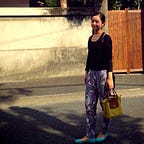I am into topics like conceptual modeling, data visualization and how to extract information to create striking visuals for simple and direct communication.
When I bumped into a series of 17century Tibetan medical paintings, the best demonstration of how ancient Tibet people unlocked the power of visual language, it immediately captivated me. Layout, structure, color coding, analogy, storytelling… you can get a lot of visualization inspiration from them.
There are 79 pieces of paintings in total. Quite astonishing volume. All in the art of Thangka (Tibetan Buddhist painting), which means painting on silky scrolls with precious natural pigments to last hundreds of years. The entire series was to illustrate a classic book of traditional Tibetan medicine, to help students in the monastery to easily learn medical knowledge. Similar purpose as today’s “infographics” or “presentation slides”.
In this post, I would like to share three stunning “trees” I discovered from this painting series.
From book illustration to art masterpiece
Before diving into the three trees, here are some background information.
Around the 8th century, a book called “Four Tantras” was written. This book covering physiology, pathology, diagnosis, and cure, forms the foundation of Tibetan medicine.
Between 1687 and 1703, Sangye Gyatso, advisor to the Fifth Dalai Lama, collaborated with many scholars to write “Blue Beryl Treatise”, a thorough written commentary and explanation of “Four Tantras”.
Besides writing, Sangye Gyatso commissioned artists to create a set of paintings to illustrate “Four Tantras”, in total 79 pieces. With the visualization, Sangye Gyamtso expected the medical system to be
perceived by everybody, from the scholar to the child, as clearly as one would see a myrobalan (a healing plant in the Tibetan tradition) held in the palm of one’s hand.
The sixteen-year project was a truly epic undertaking. To this day “Blue Beryl Treatise” remains the main reference of traditional Tibetan medical knowledge, textbook for all Tibetan medical students, while the 79 paintings act like the “mind maps” and the essential visual notes for students, doctors and professors to keep at hand.
For us, with nearly zero knowledge of Tibetan medicine, the paintings offer a glimpse into a brilliant and intricate world.
Analogy of Tree
Now let’s take a closer look at the three “trees” that fascinate me.
Clear overview
The first tantra of “Four Tantras” is called “Root Tantra”. It gives the overview of philosophy, principle and main topics of Tibetan medicine.
How did the paintings summarize “Root Tantra”? The Tibetan artists used only three trees to cover the overview:
- The tree of Physiology and Disease
- The tree of Diagnosis
- The tree of Cure
The entire medical system into three simple trees. That’s the power of simplicity and clarity.
If you count the trunks of each tree, you will notice
- The first tree has 2 trunks: the left one is about Physiology; the right side is about Disease
- The second tree has 3 trunks: each trunk representing one of the three diagnosis methods. They are Observation, Pulse taking, Asking.
- The third tree has 4 trunks: four ways of cure, Diet, Living Habit, Medicine, Surgery. Adjusting diet is considered the first and foremost option. Next is to adjust living habits. Only if neither works, medicine or surgery will be considered.
You feel the beauty? From tree to trunk, from branch to leave, the visuals create a clear structure and hierarchy.
Systematic thinking
The basic concept in Tibetan Medicine is three bodily humors. A healthy body means three humors in balance. All disorders of the body are produced by the imbalance. It is similar idea to the balance of “Yin” and ‘Yang” in traditional Chinese medicine.
In the three trees, you can see embedded color codes reflecting the three humors everywhere. This shows the consistency and systematic thinking.
The first tree introduces the concept of three humors:
- Humor of wind (“rlung”, pronounced “loong”): drawn in the color of blue
- Humor of fire (“mkhris pa”, pronounced“treeba”): in the color of yellow
- Humor of water and earth (“bad kan”, pronounced“baygan”): in the color of white
The second tree shows what can be diagnosed if one humor has disorder. For example, how the patient’s tongue can look like if there is “rlung” disorder. (Notice: The version I found was using green color for the third humor.)
The third tree lists out what to do for each humor disorder, for example what to eat when there is “rlung” disorder, etc.
Thought-provoking metaphor
You might think those Tibetan medicine trees are cool, but aren’t they similar to today’s mind mapping or tree structure diagram?
With comparison, you can easily notice today’s tree diagram starts from top to bottom or left to right. The deeper level it goes into, the more detailed and seemingly less important the information becomes.
The Tibetan medicine trees mimic the actual tree, growing from the bottom up. And on top of the tree, on the top of the Physiology trunk, there are two blooming flowers, representing Longevity (top) and Health (bottom). Furthermore, the flower of Health bears the fruit of “Wealth Accumulation” and “Spiritual Practice”, and the flower of Longevity turns into the fruit of “Peaceful Life”.
This is how the metaphor of Tree maximizes its power, beyond branching, to the outcome the whole system leads to. This is how life philosophy is woven into the Tibetan medical system.
Thanks to serendipity that opened me a new world. There are more to discover from this treasure. For example, the first painting of the whole series is called “Heavenly Abode of the Medicine Buddha”, depicting the world and its material. Another brilliant piece depicts the development of the human embryo, etc.
